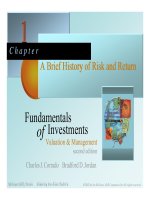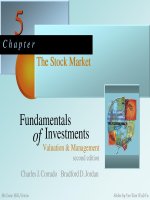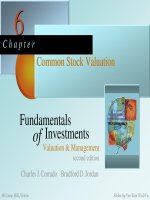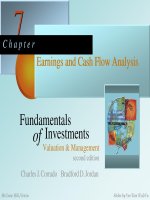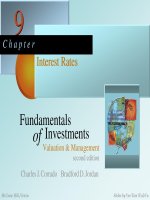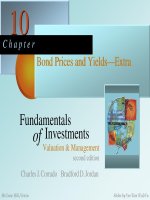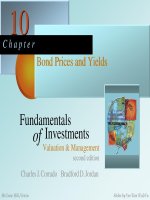Charles J. Corrado_Fundamentals of Investments - Chapter 16 ppt
Bạn đang xem bản rút gọn của tài liệu. Xem và tải ngay bản đầy đủ của tài liệu tại đây (955.06 KB, 60 trang )
CHAPTER 16
Futures Contracts
Trading in futures contracts adds a time dimension to commodity markets.
A futures contract separates the date of the agreement - when a delivery
price is specified - from the date when delivery and payment actually occur.
By separating these dates, buyers and sellers achieve an important and
flexible tool for risk management. So fundamental is this underlying principle
that it has been practiced for several millennia and is likely to be around for
several more.
A hallmark of ancient civilization was the trading of commodities at an officially designated
marketplace. Indeed, the Forum and the Agora defined Rome and Athens as centers of civilization
as much as the Pantheon and the Parthenon. While commodities trading was normally conducted on
the basis of barter or coin-and-carry, the use of what are known as forward contracts dates at least
to ancient Babylonia, where they were regulated by Hammurabi's Code.
This chapter covers modern-day versions of these activities. The first sections discuss the
basics of futures contracts and how their prices are quoted in the financial press. From there, we
move into a general discussion of how futures contracts are used and the relationship between current
cash prices and futures prices.
2 Chapter 16
(marg. def. forward contract Agreement between a buyer and a seller, who both
commit to a transaction at a future date at a price set by negotiation today.)
16.1 Futures Contract Basics
By definition, a forward contract is a formal agreement between a buyer and a seller, who
both commit to a commodity transaction at a future date at a price set by negotiation today. The
genius of forward contracting is that it allows a producer to sell a product to a willing buyer before
it is actually produced. By setting a price today, both buyer and seller remove price uncertainty as a
source of risk. With less risk, buyers and sellers mutually benefit and commerce is stimulated. This
principle has been understood and practiced for centuries.
(marg. def. futures contract Contract between a seller and a buyer specifying a
commodity or financial instrument to be delivered and paid for at contract maturity.
Futures contracts are managed through an organized futures exchange.)
(marg. def. futures price Price negotiated by buyer and seller at which the underlying
commodity or financial instrument will be delivered and paid for to fulfill the
obligations of a futures contract.)
Futures contracts represent a step beyond forward contracts. Futures contracts and forward
contracts accomplish the same economic task, which is to specify a price today for future delivery.
This specified price is called the futures price. However, while a forward contract can be struck
between any two parties, futures contracts are managed through an organized futures exchange.
Sponsorship through a futures exchange is a major distinction between a futures contract and a
forward contract.
Futures 3
History of Futures Trading
History buffs will be interested to know that organized futures trading appears to have
originated in Japan during the early Tokugawa era, that is, the seventeenth century. As you might
guess, these early Japanese futures markets were devoted to trading contracts for rice. Tokugawa rule
ended in 1867, but active rice futures markets continue on to this day.
The oldest organized futures exchange in the United States is the Chicago Board of Trade
(CBOT). The CBOT was established in 1848 and grew with the westward expansion of American
ranching and agriculture. Today, the CBOT is the largest, most active futures exchange in the world.
Other early American futures exchanges still with us today include the MidAmerica Commodity
Exchange founded in 1868, New York Cotton Exchange (1870), New York Mercantile Exchange
(1872), Chicago Mercantile Exchange (1874), New York Coffee Exchange (1882), and the Kansas
City Board of Trade (1882).
For more than 100 years, American futures exchanges devoted their activities exclusively to
commodity futures. However, a revolution began in the 1970s with the introduction of financial
futures. Unlike commodity futures, which call for delivery of a physical commodity, financial futures
require delivery of a financial instrument. The first financial futures were foreign currency contracts
introduced in 1972 at the International Monetary Market (IMM), a division of the Chicago Mercantile
Exchange (CME).
Next came interest rate futures, introduced at the Chicago Board of Trade in 1975. An
interest rate futures contract specifies delivery of a fixed-income security. For example, an interest
rate futures contract may specify a U.S. Treasury bill, note, or bond as the underlying instrument.
Finally, stock index futures were introduced in 1982 at the Kansas City Board of Trade (KBT), the
4 Chapter 16
Chicago Mercantile Exchange, and the New York Futures Exchange (NYFE). A stock index futures
contract specifies a particular stock market index as its underlying instrument.
Financial futures have been so successful that they now constitute the bulk of all futures
trading. This success is largely attributed to the fact that financial futures have become an
indispensable tool for financial risk management by corporations and portfolio managers. As we will
see, futures contracts can be used to reduce risk through hedging strategies or used to increase risk
through speculative strategies. In this chapter, we discuss futures contracts generally, but, since this
text deals with financial markets, we will ultimately focus on financial futures.
Futures Contract Features
Futures contracts are a type of derivative security because the value of the contract is derived
from the value of an underlying instrument. For example, the value of a futures contract to buy or sell
gold is derived from the market price of gold. However, because a futures contract represents a zero-
sum game between a buyer and a seller, the net value of a futures contract is always zero. That is, any
gain realized by the buyer is exactly equal to a loss realized by the seller, and vice versa.
Futures are contracts, and, in practice, exchange-traded futures contracts are standardized to
facilitate convenience in trading and price reporting. Standardized futures contracts have a set
contract size specified according to the particular underlying instrument. For example, a standard gold
futures contract specifies a contract size of 100 troy ounces. This means that a single gold futures
contract obligates the seller to deliver 100 troy ounces of gold to the buyer at contract maturity. In
turn, the contract also obligates the buyer to accept the gold delivery and pay the negotiated futures
price for the delivered gold.
Futures 5
To properly understand a futures contract, we must know the specific terms of the contract.
In general, futures contracts must stipulate at least the following five contract terms:
1. The identity of the underlying commodity or financial instrument,
2. The futures contract size,
3. The futures maturity date, also called the expiration date, and
4. The delivery or settlement procedure,
5. The futures price.
First, a futures contract requires that the underlying commodity or financial instrument be
clearly identified. This is stating the obvious, but it is important that the obvious is clearly understood
in financial transactions.
Second, the size of the contract must be specified. As stated earlier, the standard contract size
for gold futures is 100 troy ounces. For U.S. Treasury note and bond futures, the standard contract
size is $100,000 in par value notes or bonds, respectively.
The third contract term that must be stated is the maturity date. Contract maturity is the date
on which the seller is obligated to make delivery and the buyer is obligated to make payment.
Fourth, the delivery process must be specified. For commodity futures, delivery normally
entails sending a warehouse receipt for the appropriate quantity of the underlying commodity. After
delivery, the buyer pays warehouse storage costs until the commodity is sold or otherwise disposed.
Finally, the futures price must be mutually agreed on by the buyer and seller. The futures price
is quite important, since it is the price that the buyer will pay and the seller will receive for delivery
at contract maturity.
6 Chapter 16
Figure 16.1 about here
For financial futures, delivery is often accomplished by a transfer of registered ownership. For
example, ownership of U.S. Treasury bill, note, and bond issues is registered at the Federal Reserve
in computerized book-entry form. Futures delivery is accomplished by a notification to the Fed to
effect a change of registered ownership.
Other financial futures feature cash settlement, which means that the buyer and seller simply
settle up in cash with no actual delivery. We discuss cash settlement in more detail when we discuss
stock index futures. The important thing to remember for now is that delivery procedures are selected
for convenience and low cost. Specific delivery procedures are set by the futures exchange and may
change slightly from time to time.
Futures Prices
The largest volume of futures trading in the United States takes place at the Chicago Board
of Trade, which accounts for about half of all domestic futures trading. However, futures trading is
also quite active at other futures exchanges. Current futures prices for contracts traded at the major
futures exchanges are reported each day in the Wall Street Journal. Figure 16.1 reproduces a portion
of the daily “Futures Prices” report of the Wall Street Journal.
This section of the Journal contains a box labeled “Exchange Abbreviations,” which lists the
major world futures exchanges and their exchange abbreviation codes. Elsewhere, the information
is divided into sections according to categories of the underlying commodities or financial
instruments. For example, the section, “Grains and Oilseeds,” contains futures price information for
Futures 7
wheat, oats, soybeans, and similar crops. The section “Metals and Petroleum” reports price
information for copper, gold, and petroleum products. There are separate sections for financial
futures, which include “Currency,” “Interest Rate,” and “Index” categories.
Each section states the contract name, futures exchange, and contract size, along with price
information for various contract maturities. For example, under “Metals and Petroleum” we find the
Copper contract traded at the Commodities Exchange (COMEX) Division of the New York
Mercantile Exchange (CMX.Div.NYM). The standard contract size for copper is 25,000 pounds per
contract. The futures price is quoted in cents per pound.
Example 16.1 Futures Quotes In Figure 16.1, locate the gold contract. Where is it traded? What does
one contract specify?
The gold contract, like the copper contract, trades on the COMEX. One contract calls for
delivery of 100 troy ounces. The futures price is quoted in dollars per ounce.
The reporting format for each futures contract is similar. For example, the first column of a
price listing gives the contract delivery/maturity month. For each maturity month, the next five
columns report futures prices observed during the previous day at the opening of trading (“Open”),
the highest intraday price (“High”), the lowest intraday price (“Low”), the price at close of trading
(“Settle”), and the change in the settle price from the previous day (“Change”).
The next two columns (“Lifetime,” “High and Low”) report the highest and lowest prices for
each maturity observed over the previous year. Finally, the last column reports Open Interest for each
contract maturity, which is the number of contracts outstanding at the end of that day's trading. The
last row below these eight columns summarizes trading activity for all maturities by reporting
aggregate trading volume and open interest for all contract maturities.
8 Chapter 16
By now, we see that four of the contract terms for futures contracts are stated in the futures
prices listing. These are:
1. The identity of the underlying commodity or financial instrument,
2. The futures contract size,
3. The futures maturity date,
4. The futures price.
Exact contract terms for the delivery process are available from the appropriate futures exchange on
request.
Example 16.2 Futures Prices In Figure 16.1, locate the soybean contract with the greatest open
interest. Explain the information provided.
The soybean (or just “bean”) contract with the greatest open interest is specified by the
contract maturity with the greatest number of contracts outstanding, so the March contract is the one
we seek. One contract calls for delivery of 5,000 bushels of beans (a bushel, of course, is four pecks).
The closing price for delivery at that maturity is stated as a quote in cents per bushel. Since there are
5,000 bushels in a single contract, the total contract value is the quoted price per bushel times 5,000,
or $23,700 for the March contract.
To get an idea of the magnitude of financial futures trading, take a look at the first entry under
“Interest Rate” in Figure 16.1, the CBT Treasury Bond contract. One contract calls for the delivery
of $100,000 in par value bonds. The total open interest in this one contract is often close to half a
million contracts. Thus the total face value represented by these contracts is close to half a trillion
dollars.
Who does all this trading? Well the orders originate from money managers around the world
and are sent to the various exchanges’ trading floors for execution. On the floor, the orders are
executed by professional traders who are quite aggressive at getting the best prices. On the floor and
off, futures traders can be recognized by their colorful jackets. As the Wall Street Journal article in
Futures 9
Investment Updates: Garrish Jackets
the nearby Investment Update box reports, these garish jackets add a touch of clamor to the trading
pits. In the next section we will discuss how and why futures contracts are used for speculation and
hedging.
CHECK THIS
16.1a What is a forward contract? A futures contract?
16.1b What is a futures price?
16.2 Why Futures?
Futures contracts can be used for speculation or for hedging. Certainly, hedging is the major
economic purpose for the existence of futures markets. However, a viable futures market cannot exist
without participation by both hedgers and speculators. Hedgers transfer price risk to speculators, and
speculators absorb price risk. Hedging and speculating are complementary activities. We next discuss
speculating with futures; and then we discuss hedging with futures.
Speculating with Futures
Suppose you are thinking about speculating on commodity prices because you believe you
can accurately forecast future prices most of the time. The most convenient way to speculate is with
futures contracts. If you believe that the price of gold will go up, then you can speculate on this belief
by buying gold futures. Alternatively, if you think gold will fall in price, you can speculate by selling
10 Chapter 16
gold futures. To be more precise, you think that the current futures price is either too high or too low
relative to what gold prices will be in the future.
Buying futures is often referred to as “going long,” or establishing a long position. Selling
futures is often called “going short,” or establishing a short position. A speculator accepts price risk
in order to bet on the direction of prices by going long or short.
(marg. def. long position In futures jargon, refers to the contract buyer. A long
position profits from a futures price increase.)
(marg. def. short position In futures jargon, refers to the seller. A short position
profits from a futures price decrease.)
(marg. def. speculator Trader who accepts price risk by going long or short to bet
on the future direction of prices.)
To illustrate the basics of speculating, suppose you believe the price of gold will go up. In
particular, the current futures price for delivery in three months is $400 per ounce. You think that
gold will be selling for more than that three months from now, so you go long 100 three-month gold
contracts. Each gold contract represents 100 troy ounces, so 100 contracts represents 10,000 ounces
of gold with a total contract value of 10,000 × $400 = $4,000,000. In futures jargon, this is a
$4 million long gold position.
Now, suppose your belief turns out to be correct and at contract maturity the market price
of gold is $420 per ounce. From your long futures position, you accept delivery of 10,000 troy
ounces of gold at $400 per ounce and immediately sell the gold at the market price of $420 per
ounce. Your profit is $20 per ounce or 10,000 × $20 = $200,000, less applicable commissions.
Of course, if your belief turned out wrong and gold fell in price, you would lose money since
you must still buy the 10,000 troy ounces at $400 per ounce to fulfill your futures contract
Futures 11
obligations. Thus, if gold fell to, say, $390 per ounce, you would lose $10 per ounce or
10,000 × $10 = $100,000. As this example suggests, futures speculation is risky, but it is potentially
rewarding if you can accurately forecast the direction of future commodity price movements.
As another example of commodity speculation, suppose an analysis of weather patterns has
convinced you that the coming winter months will be warmer than usual, and that this will cause
heating oil prices to fall as unsold inventories accumulate. You can speculate on this belief by selling
heating oil futures.
Figure 16.1 reveals that the standard contract size for heating oil is 42,000 gallons. Suppose
you go short 10 contracts at a futures price of 55 cents per gallon. This represents a short position
with a total contract value of 10 × 42,000 × $.55 = $231,000.
If, at contract maturity, the price of heating oil is, say, 50 cents per gallon, you could buy
420,000 gallons for delivery to fulfill your futures commitment. Your profit would be 5 cents per
gallon, or 10 × 42,000 × $.05 = $21,000, less applicable commissions. Of course, if heating oil prices
rise by 5 cents per gallon, you would lose $21,000 instead. Again, speculation is risky but rewarding
if you can accurately forecast the weather.
Example 16.3 What Would Juan Valdez Do? After an analysis of political currents in Central and
South America, you conclude that future coffee prices will be lower than currently indicated by
futures prices. Would you go long or short? Analyze the impact of a swing in coffee prices of 10
cents per pound in either direction if you have a 10-contract position, where each contract calls for
delivery of 37,500 pounds of coffee.
You would go short since you expect prices to decline. You’re short 10 contracts, so you
must deliver 10×37,500 = 375,000 pounds of coffee. If coffee prices fall to 10 cents below your
originally contracted futures price, then you make 10 cents per pound, or $37,500. Of course, if
you’re wrong and prices are 10 cents higher, you lose $37,500.
12 Chapter 16
Hedging With Futures
Many businesses face price risk when their activities require them to hold a working inventory.
For example, suppose you own a regional gasoline distributorship and must keep a large operating
inventory of gas on hand, say, 5 million gallons. In futures jargon, this gasoline inventory represents
a long position in the underlying commodity.
If gas prices go up, your inventory goes up in value; but if gas prices fall, your inventory value
goes down. Your risk is not trivial, since even a 5-cent fluctuation in the gallon price of gas will cause
your inventory to change in value by $250,000. Because you are in the business of distributing gas,
and not speculating on gas prices, you would like to remove this price risk from your business
operations. Acting as a hedger, you seek to transfer price risk by taking a futures position opposite
to an existing position in the underlying commodity or financial instrument. In this case, the value of
your gasoline inventory can be protected by selling gasoline futures contracts.
(marg. def. hedger Trader who seeks to transfer price risk by taking a futures
position opposite to an existing position in the underlying commodity or financial
instrument.)
Gasoline futures are traded on the New York Mercantile exchange (NYM), and the standard
contract size for gasoline futures is 42,000 gallons per contract. Since you wish to hedge 5 million
gallons, you need to sell 5,000,000 / 42,000 = 119 gasoline contracts. With this hedge in place, any
change in the value of your long inventory position is canceled by an approximately equal but
opposite change in value of your short futures position. Because you are using this short position for
hedging purposes, it is called a short hedge.
(marg. def. short hedge Sale of futures to offset potential losses from falling prices.)
Futures 13
By hedging, you have greatly reduced or even eliminated the possibility of a loss from a
decline in the price of gasoline. However, you have also eliminated the possibility of a gain from a
price increase. This is an important point. If gas prices rise, you would have a substantial loss on your
futures position, offsetting the gain on your inventory. Overall, you are long the underlying
commodity because you own it; you offset the risk in your long position with a short position in
futures.
Of course, your business activities may also include distributing other petroleum products like
heating oil and natural gas. Futures contracts are available for these petroleum products also, and
therefore they may be used for inventory hedging purposes.
Example 16.4 Short Hedging Suppose you have an inventory of 1.2 million pounds of soybean oil.
Describe how you would hedge this position.
Since you are long in the commodity, bean oil, you need to go short in (sell) futures. A single
bean oil contract calls for delivery of 60,000 pounds of oil. To hedge your position, you need to sell
1.2 million / 60,000 = 20 futures contracts.
(marg. def. long hedge Purchase of futures to offset potential losses from rising
prices.)
The opposite of a short hedge is a long hedge. In this case, you do not own the underlying
commodity, but you need to acquire it in the future. You can lock in the price you will pay in the
future by buying, or going long in, futures contracts. In effect, you are short the underlying
commodity because you must buy it in the future. You offset your short position with a long position
in futures.
Example 16.5: More Hedging You need to buy 600,000 pounds of orange juice in three months.
How can you hedge the price risk associated with this future purchase? What price will you
effectively lock in? One orange juice contract calls for delivery of 15,000 pounds of juice concentrate.
You are effectively short orange juice since you don’t currently own it but plan to buy it. To
offset the risk in this short position, you need to go long in futures. You should buy
600,000 / 15,000 = 40 contracts. The price you lock in is the original futures price.
14 Chapter 16
Example 16.6 Even More Hedging Suppose your company will receive payment of £10 million in six
months, which will then be converted to U.S. dollars. What is the standard futures contract size for
British pounds? Describe how you could use futures contracts to lock in an exchange rate from
British pounds to U.S. dollars for your planned receipt of £10 million, including how many contracts
are required.
Your company will be receiving £10 million, so you are effectively long pounds. To hedge,
you need to short (sell) futures contracts. Put differently, you will want to exchange pounds for
dollars. By selling a futures contract, you obligate yourself to deliver the underlying commodity, in
this case currency, in exchange for payment in dollars. One British pound contract calls for delivery
of £62,500. You will therefore sell £10 million / £62,500 = 160 contracts.
CHECK THIS
16.2a What is a long position in futures? A short position? For a speculator, when is each
appropriate?
16.2b What is a long hedge? A short hedge?
16.3 Futures Trading Accounts
A futures exchange, like a stock exchange, allows only exchange members to trade on the
exchange. Exchange members may be firms or individuals trading for their own accounts, or they may
be brokerage firms handling trades for customers. Some firms conduct both trading and brokerage
operations on the exchange. In this section, we discuss the mechanics of a futures trading account as
it pertains to a customer with a trading account at a brokerage firm.
The biggest customer trading accounts are those of corporations that use futures to manage
their business risks and money managers who hedge or speculate with clients' funds. Many individual
investors also have futures trading accounts of their own, although speculation by individual investors
is not recommended without a full understanding of all risks involved. Whether a futures trading
account is large or small, the mechanics of account trading are essentially the same.
Futures 15
(marg. def. futures margin Deposit of funds in a futures trading account dedicated
to covering potential losses from an outstanding futures position.)
(marg. def. initial margin Amount required when a futures contract is first bought
or sold. Initial margin varies with the type and size of a contract, but it is the same for
long and short futures positions.)
There are several essential things to know about futures trading accounts. The first thing to
know about a futures trading account is that margin is required. In this way, futures accounts
resemble the stock margin accounts we discussed in Chapter 2; however, the specifics are quite
different. Futures margin is a deposit of funds in a futures trading account dedicated to covering
potential losses from an outstanding futures position. An initial margin is required when a futures
position is first established. The amount varies according to contract type and size, but margin
requirements for futures contracts usually range between 2 percent to 5 percent of total contract
value. Initial margin is the same for both long and short futures positions.
(marg. def. marking-to-market In futures trading accounts, the process whereby
gains and losses on outstanding futures positions are recognized on a daily basis.)
The second thing to know about a futures trading account is that contract values in
outstanding futures positions are marked to market on a daily basis. Marking-to-market is a process
whereby gains and losses on outstanding futures positions are recognized at the end of each day's
trading.
For example, suppose one morning you call your broker and instruct her to go long five U.S.
Treasury bond contracts for your account. A few minutes later, she calls back to confirm order
execution at a futures price of 110. Since the Treasury bond contract size is $100,000 par value,
contract value is 110% × $100,000 = $110,000 per contract. Thus the total position value for your
order is $550,000, for which your broker requires $30,000 initial margin. In addition, your broker
16 Chapter 16
requires that at least $25,000 in maintenance margin be present at all times. The necessary margin
funds are immediately wired from a bank account to your futures account.
(marg. def. maintenance margin The minimum margin level required in a futures
trading account at all times.)
Now, at the end of trading that day Treasury bond futures close at a price of 108. Overnight,
all accounts are marked to market. Your Treasury bond futures position is marked to $108,000 per
contract or $540,000 total position value, representing a loss of $10,000. This loss is deducted from
your initial margin to leave only $20,000 of margin funds in your account.
(marg. def. margin call Notification to increase the margin level in a trading
account.)
Since the maintenance margin level on your account is $25,000, your broker will issue a
margin call on your account. Essentially, your broker will notify you that you must immediately
restore your margin level to the initial margin level of $30,000, or else she will close out your
Treasury bond futures position at whatever trading price is available at the exchange.
This example illustrates what happens when a futures trading account is marked to market and
the resulting margin funds fall below the maintenance margin level. The alternative, and more pleasant
experience occurs when a futures price moves in your favor, and the marking-to-market process adds
funds to your account. In this case, marking-to-market gains can be withdrawn from your account
so long as remaining margin funds are not less than the initial margin level.
Futures 17
(marg. def. reverse trade A trade that closes out a previously established futures
position by taking the opposite position.)
The third thing to know about a futures trading account is that a futures position can be
closed out at any time; you do not have to hold a contract until maturity. A futures position is closed
out by simply instructing your broker to close out your position. To actually close out a position,
your broker will enter a reverse trade for your account.
A reverse trade works like this: Suppose you are currently short five Treasury bond contracts,
and you instruct your broker to close out the position. Your broker responds by going long five
Treasury bond contracts for your account. In this case, going long five contracts is a reverse trade
because it cancels exactly your previous five-contract short position. At the end of the day of your
reverse trade, your account will be marked to market at the futures price realized by the reverse trade.
From then on, your position is closed out and no more gains or losses will be realized.
This example illustrates that closing out a futures position is no more difficult than initially
entering into a position. There are two basic reasons to close out a futures position before contract
maturity. The first is to capture a current gain or loss, without realizing further price risk. The second
is to avoid the delivery requirement that comes from holding a futures contract until it matures. In
fact, over 98 percent of all futures contracts are closed out before contract maturity, which indicates
that less than 2 percent of all futures contracts result in delivery of the underlying commodity or
financial instrument.
Before closing this section, let’s briefly list the three essential things to know about a futures
trading account as discussed above:
18 Chapter 16
1. Margin is required,
2. Futures accounts are marked-to-market daily,
3. A futures position can be closed out any time by a reverse trade.
Understanding the items in this list is important to anyone planning to use a futures trading account.
CHECK THIS
16.3a What are the three essential things you should know about a futures trading account?
16.3b What is meant by initial margin for a futures position? What is meant by maintenance margin
for a futures position?
16.3c Explain the process of marking to market a futures trading account? What is a margin call,
and when is one issued?
16.3d How is a futures position closed out by a reverse trade? What proportion of all futures
positions are closed out by reverse trades rather than by delivery at contract maturity?
16.4 Cash Prices Versus Futures Prices
We now turn to the relationship between the today’s price of some commodity or financial
instruments and its futures price. We begin by examining current cash prices.
Futures 19
Figure 16.2 about here
(marg. def. cash price Price of a commodity or financial instrument for current
delivery. Also called the spot price.)
(marg. def. cash market Market in which commodities or financial instruments are
traded for essentially immediate delivery. Also called the spot market.)
Cash Prices
The cash price of a commodity or financial instrument is the price quoted for current delivery.
The cash price is also called the spot price, as in “on the spot.” In futures jargon, terms like “spot
gold” or “cash wheat” are used to refer to commodities being sold for current delivery in what is
called the cash market or the spot market.
Figure 16.2 reproduces the “Cash Prices” column of the Wall Street Journal, published the
same day as the “Futures Prices” column seen shown in Figure 16.1. The column is divided into
sections according to commodity categories. For example, the first section “Grains and Feeds”
contains spot price information for wheat, corn, soybeans, and similar crops. Other commodity
sections include “Foods, Fats and Oils,” “Metals,” and “Precious Metals.” Each section gives
commodity names along with cash market prices for the last two days of trading and one year earlier.
Cash-Futures Arbitrage
Intuitively, you might think that there is a close relationship between the cash price of a
commodity and its futures price. If you do, then your intuition is quite correct. In fact, your intuition
is backed up by strong economic argument and more than a century of experience observing the
simultaneous operation of cash and futures markets.
20 Chapter 16
1
Confusingly, basis is sometimes presented as the futures price less the cash price. The
official Commodity Trading Manual of the Chicago Board of Trade defines basis as the difference
between the cash and the futures price, i.e., basis = cash price - futures price. We will be
consistent with the CBOT definition.
As a routine matter, cash and futures prices are closely watched by market professionals. To
understand why, suppose you notice that spot gold is trading for $400 per ounce while the two-month
futures price is $450 per ounce. Do you see a profit opportunity?
You should, because buying spot gold today at $400 per ounce while simultaneously selling
gold futures at $450 per ounce locks in a $50 per ounce profit. True, gold has storage costs (you
have to put it somewhere), and a spot gold purchase ties up capital that could be earning interest.
However, these costs are small relative to the $50 per ounce gross profit, which works out to be
$50 / $400 = 12.5% per two months, or about 100% per year (with compounding). Furthermore, this
profit is risk-free! Alas, in reality, such easy profit opportunities are the stuff of dreams.
(marg. def. cash-futures arbitrage Earning risk-free profits from an unusually large
difference between cash and futures prices.
Earning risk-free profits from an unusual difference between cash and futures prices is called
cash-futures arbitrage. In a competitive market, cash-futures arbitrage has very slim profit margins.
In fact, the profit margins are almost imperceptible when they exist at all.
(marg. def. basis The difference between the cash price and the futures price for a
commodity, i.e., basis = cash price - futures price.)
Comparing cash prices for commodities in Figure 16.2 with their corresponding futures prices
reported in Figure 16.1, you will find that cash prices and futures prices are seldom equal. In futures
jargon, the difference between a cash price and a futures price is called basis.
1
Futures 21
(marg. def. carrying-charge market Refers to the case where the futures price is
greater than the cash price; i.e., the basis is negative.)
(marg. def. inverted market The case where the futures price is less than the cash
price; i.e., the basis is positive.)
For commodities with storage costs, the cash price is usually less than the futures price. This
is referred to as a carrying-charge market. Sometimes, however, the cash price is greater than the
futures price and this is referred to as an inverted market. We can summarize this discussion of
carrying-charge markets, inverted markets, and basis as follows:
Carrying-charge market: Basis = Cash price - Futures price < 0 [16.1]
Inverted market: Basis = Cash price - Futures price > 0
A variety of factors can lead to an economically justifiable difference between a commodity's
cash price and its futures price, including availability of storage facilities, transportation costs, and
seasonal price fluctuations. However, the primary determinants of cash-futures bases are storage costs
and interest costs. Storage cost is the cost of holding the commodity in a storage facility, and interest
cost refers to interest income forgone because funds are being used to buy and hold the commodity.
If a futures price rises far enough above a cash price to more than cover storage costs and
interest expense, commodity traders will undertake cash-futures arbitrage by buying in the cash
market and selling in the futures market. This drives down the futures price and drives up the cash
price until the basis is restored to an economically justifiable level.
Similarly, if a futures price falls far enough relative to a cash price, traders will undertake
cash-futures arbitrage by short selling in the cash market and buying in the futures market. This drives
22 Chapter 16
2
For the sake of simplicity,
ignore the fact that individual investors don’t earn interest
on the proceeds from a short
down the cash price and drives up the futures price until an economically justifiable basis is restored.
In both cases, arbitrage ensures that the basis is kept at an economically appropriate level.
Spot-Futures Parity
We can be a little bit more precise concerning the relationship between spot and futures prices
for financial futures. To illustrate, suppose we had a futures contract on shares of common stock in
a single company (actually there are no such contracts in the U.S.). This particular stock does not pay
dividends.
For concreteness, suppose the contract calls for delivery of 1,000 shares of stock in one year.
The current (i.e., cash or spot) price is $50 per share. Also, 12-month T-bills are yielding 6 percent.
What should the futures price be? To answer, notice that you can buy 1,000 shares of stock for $50
per share, or $50,000 total. You can eliminate all of the risk associated with this purchase by selling
one futures contract. The net effect of this transaction is that you have created a risk-free asset. Since
the risk-free rate is 6 percent, your investment must have a future value of $50,000 × 1.06 = $53,000.
In other words, the futures price should be $53 per share.
Suppose the futures price is, in fact, $52 per share. What would you do? To make a great deal
of money, you would short 1,000 shares of stock at $50 per share and invest the $50,000 proceeds
at 6 percent.
2
Simultaneously, you would buy one futures contract.
Futures 23
At the end of the year, you would have $53,000. You would use $52,000 to buy the stock
to fulfill your obligation on the futures contract and then return the stock to close out the short
position. You pocket $1,000. This is just another example of cash-futures arbitrage.
More generally, if we let F be the futures price, S be the spot price, and r be the risk-free rate,
then our example illustrates that
F = S(1 + r) [16.2]
In other words, the futures price is simply the future value of the spot price, calculated at the risk-free
rate. This is the famous spot-futures parity condition. This condition must hold in the absence of
cash-futures arbitrage opportunities.
(marg. def. spot-futures parity The relationship between spot prices and futures
prices that holds in the absence of arbitrage opportunities.)
More generally, if r is the risk-free rate per period, and the futures contract matures in T
periods, then the spot-futures parity condition is
F = S(1 + r)
T
[16.3]
Notice that T could be a fraction of one period. For example, if we have the risk-free rate per year,
but the futures contract matures in six months, T would be ½.
Example 16.7 Parity Check A non-dividend-paying stock has a current price of $12 per share. The
risk-free rate is 4 percent per year. If a futures contract on the stock matures in 3 months, what
should the futures price be?
From our spot-futures parity condition, we have
F = S(1 + r)
T
= $12(1.04)¼
= $12.12
The futures price should be $12.12. Notice that T, the number of periods, is ¼ because the contract
matures in one quarter.
24 Chapter 16
More on Spot-Futures Parity
In our spot-futures parity example just above, we assumed that the underlying financial
instrument (the stock) had no cash flows (no dividends). If there are dividends (for a stock future)
or coupon payments (for a bond future), then we need to modify our spot-futures parity condition.
For a stock, we let D stand for the dividend, and we assume that the dividend is paid in one
period, at or near the end of the futures contract’s life. In this case, the spot-futures parity condition
becomes
F = S(1 + r) - D [16.4]
Notice that we have simply subtracted the amount of the dividend from the future value of the stock
price. The reason is that if you buy the futures contract, you will not receive the dividend, but the
dividend payment will reduce the stock price.
An alternative, and very useful, way of writing the dividend-adjusted spot-futures parity result
in Equation 16.4 is to define d as the dividend yield on the stock. Recall that the dividend yield is just
the upcoming dividend divided by the current price. In our current notation, this is just d = D/S. With
this in mind, we can write the dividend-adjusted parity result as
F = S(1 + r) - D (S/S) [16.5]
= S(1 + r) - S (D/S)
= S(1 + r) - Sd
= S(1 + r - d)
Finally, as above, if there is something other than a single period involved, we would write
F = S(1 + r - d)
T
[16.6]
where T is the number of periods (or fraction of a period).
Futures 25
For example, suppose there is a futures contract on a stock with a current price of $80. The
futures contract matures in six months. The risk-free rate is 7 percent per year, and the stock has an
annual dividend yield of 3 percent. What should the futures price be?
Plugging in to our dividend-adjusted parity equation, we have
F = S(1 + r - d)
T
= $80(1 + .07 - .03)
½
= $81.58
Notice that we set T equal to ½ since the contract matures in six months.
CHECK THIS
16.4a What is the spot price for a commodity?
16.4b With regard to futures contracts, what is the basis?
16.4c What is an inverted market?
16.4d What is the spot-futures parity condition?
16.5 Stock Index Futures
While there are no futures contracts on individual stocks, there are a number of contracts on
stock market indexes. Because these contracts are particularly important, we devote this entire
section to them. We first describe the contracts and then discuss some trading and hedging strategies
involving their use.

